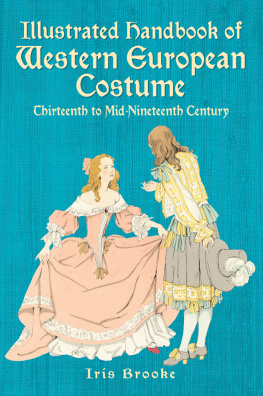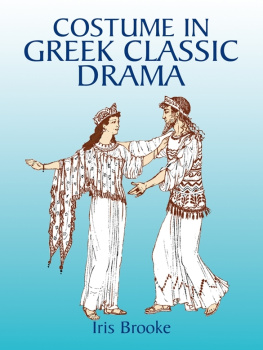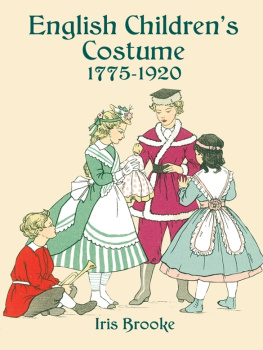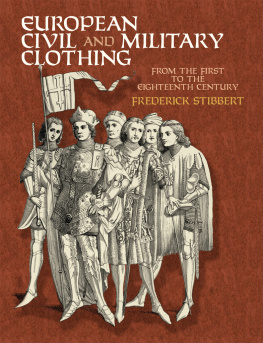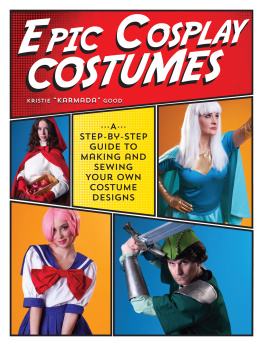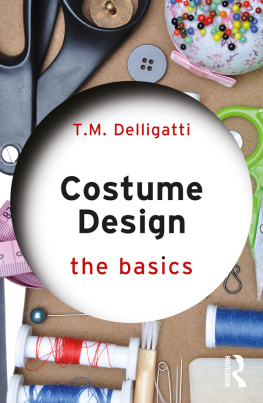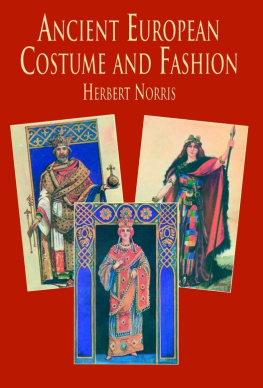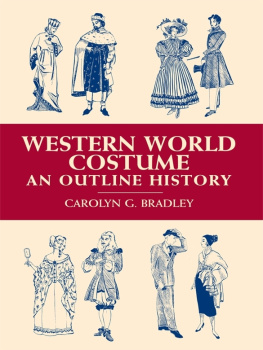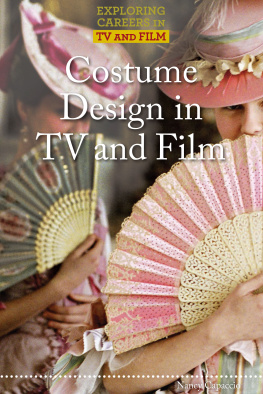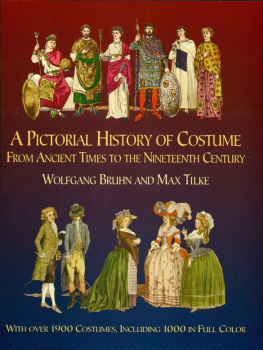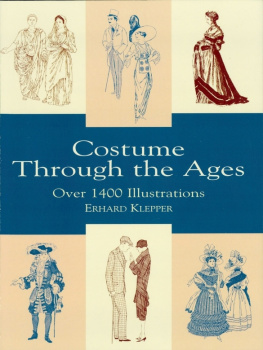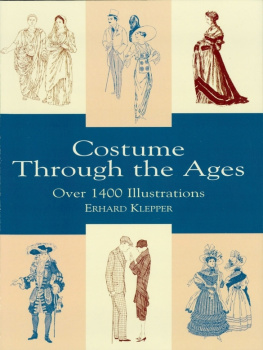ILLUSTRATED HANDBOOK OF WESTERN EUROPEAN COSTUME
THIRTEENTH TO MID-NINETEENTH CENTURY
TWO VOLUMES BOUND AS ONE
VOLUME ONE: THIRTEENTH TO SEVENTEENTH CENTURY
IRIS BROOKE
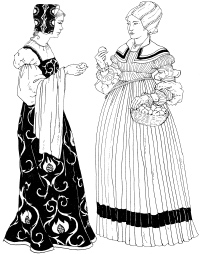
DOVER PUBLICATIONS, INC.
Mineola, New York
Bibliographical Note
This Dover edition, first published in 2003, is an unabridged republication of the following two volumes bound as one: Western European Costume: Thirteenth to Seventeenth Century, And Its Relation to the Theatre (Volume One) and Western European Costume: Seventeenth to Mid-Nineteenth Century, And Its Relation to the Theatre (Volume Two) originally published in 1939 and 1940, respectively, by George G. Harrap & Co. Ltd., London. The only significant alteration consists in moving all thirty-two color plates (from both volumes) into a full-color insert after of Volume One.
Library of Congress Cataloging-in-Publication Data
Brooke, Iris.
[Western European costume... and its relation to the theatre]
Illustrated handbook of Western European costume, thirteenth to mid-nineteenth century / Iris Brooke.
p. cm.
Two volumes bound as one.
An unabridged republication of the following two volumes bound as one: Western European costume, thirteenth to seventeenth century, and its relation to the theatre (volume one) and Western European costume, seventeenth to mid-nineteenth century, and its relation to the theatre (volume two), originally published in 1939 and 1940 respectively by George G. Harrap & Co., Ltd., LondonVerso t.p.
Includes index.
eISBN 13: 978-0-486-14912-7
1. CostumeEuropeHistory. I. Title.
GT270.B73 2003
391.0094dc21
2002041669
Manufactured in the United States of America
Dover Publications, Inc., 31 East 2nd Street, Mineola, N.Y. 1150l
ILLUSTRATIONS
PLATES IN COLOUR
ILLUSTRATIONS IN THE TEXT
. (1260) The simple gown, cloak, and head-dress of the thirteenth century (German).
. (1280) The crespin, barbette, and fillet, together with the more decorative etceteras worn by a lady of quality (French).
. (1230) Horizontal stripes and a long jewelled belt liven the monotony of the standard lines worn in Germany.
. (1260) French fashions.
. (1260) The Italian style of following the classical lines.
. (1210) Bands of embroidery used to decorate masculine tunics (German).
. (1260) Different arrangements of the braies and hose, and the two most general fashions for men.
. (1280) Lavish application of jewels, worn by courtly gentlemen, and the simple ungirdled dress of the well-dressed lady of the late thirteenth century (German).
. (1300) Peasant style. Coif and cap and soled hose (Italian).
. (1450) The hood.
. (About 1250) Two versions of the garde-corps, as worn by men (French).
. (1330) An Italian lady of quality.
. About 1370) An unusual high-waisted dress, with a train (Italian).
. (1340) The hood and cloak and delightful Italian variations in feminine fashions.
. (1337) The simpler styles of the Italian people.
. (1390) French version of the sideless surcote and the latest method of head-dressing.
. (1361) Knuckle-length sleeves, with buttons to the elbow, the tippet finish of the upper sleeve, and the then prevalent fashion for fastening the cloak at the shoulder. The ladys head-dress is the Kruseler (German).
. (1340) (A) Parti-coloured tunic, with a lipped sleeve. (B) Fitchet and split skirt together with a more loosely frilled veil (German).
. (1319) Danish version of sideless surcote with the old method of securing the cloak, wimple, and head veil.
. (1380) (A) The garnache, or cape-sleeved super-tunic. (B) Very formal arrangement of the hair in metal casings (French).
. (1390) (A) A net worn over the hair. Hanging sleeve and fichets. (B) The short, waisted tunic with buttons and a neck-chain as decoration, long-pointed toes (French).
. (1395) (A) Dagging and the use of bells for decorative purposes. (B) Houpelande (German).
. (1395) Various arrangements of bells (German) .
. (1400). The Kruseler, with the sides pinned under the chin (German).
. (1400) Two arrangements of the hood, lipped sleeve, and split skirt decorated with embroidered bands (German).
. (1430) (A) The shortened houpelande bag-sleeves, and beaver hat. (B) Rolled head-dress (Dutch).
. (1440) Enveloping draperies of a Spanish lady.
. (1440) Italian peasant styles.
. (1414) The employment of dagging on all possible garments (French).
. Evolution of the hood.
. (1440) Peculiar Italian fashions in mens hats
. (1445) Exaggerated interpretations of the caped-sleeved tunic (Italian).
. (1428) Fantastic Italian fashions.
. (1427) Low-waisted German style.
. (1450) (A) The short-skirted, wide-shouldered tunic, typical of the latter half of the century. (B, C, and D) The hennin, horned, and rolled head dresses (French).
. (1470) Fantastic German hats.
. (1440) Italian houpelande with sleeves turned back.
. (1490) Striking fashions in patterned hose, and short slashed doublet of Venetian origin (Italian).
. (1490) Sleeveless over-tunic (German).
. (1460) The detachable sleeve (German).
. (1490) Exaggerated ribbon-slashing and netted hair (French).
. (1480) A simple Italian doublet, with hood attached.
. (1400) Italian peasant fashions.
. (1410) The bag-sleeve and waisted gown without girdle (Dutch).
. (1430) Heavy Dutch styles following the prevalent fashions.
. (About 1400) A gathered skirt and sweeping dagged sleeves (Italian).
. (1490) A German hennin head-dress with formal plaits ; short, tight-fitting over-tunic.
. (About 1460) Two varieties in a double-pointed head-dress (French).
. (14901500) Three German styles of waisted gowns and stiffly arranged head-dresses.
. (1440) Variations of the more familiar fifteenth century fashions (Flemish).
. The adaptation of the same style by four different countries. (A) Italian, i486; (B) French, 1500; (C) German, 1500; (D) Flemish, 1487.
. (1460) Fur-edged German garments
. (1470) Four head-dresses worn by German women.
. The Italian fashion for hair nets and pearls. (A) 1489 ; (B) 1500; (C) 1464.
. (1430) Quaint head-dress of Italian lady.
. }(1480) Italian arrangements of the hair during the latter half of the century.
. (1505) A style from Portugal, with an amusing fashion in hairdressing.
. (1537) The gigantic sleeves, short waist, and full skirts, fashionable in both Germany and Italy (Italian).
. (1500) Slashed sleeves and the use of tiny bows to hold the more minute slashings in place (Italian.
. (1510) The striking differences between the Italian and German fashions of 1510.
. (1514) Quaint fashion in Dutch bonnet, with the hair drawn through the sides.
. (1520) German cap.
. (1515) Several variations in French fashions.
. (1515) A typical French lady.
. (About 1500) Typically transitional fashions from the fifteenth to the sixteenth century (French).
. (1523) The Spanish hair net.
. (1515) Slashed hose and short doublet were worn at the same time as the full-skirted tunic (French).
. Fashions in hose decoration. (A) French ; (B) Italian; (C) Venetian; (D) German.
. (1530) Ornate variations in the fashionable manner (French)
. (About 1540) (A) Low-rounded neckline and slashed sleeves;
Next page
